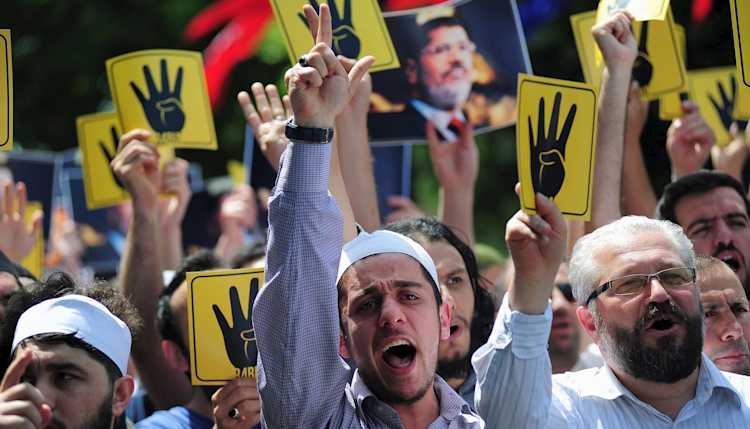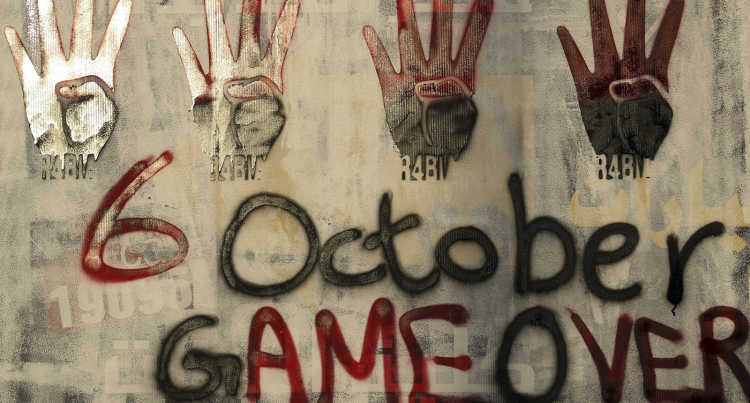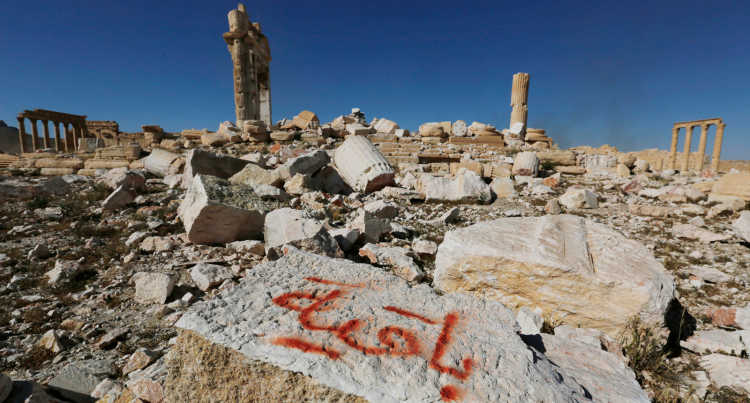- Home
- Publications
- GIGA Focus
- Sunni Political Islam: Grasping the Emerging Divide
GIGA Focus Middle East
Sunni Political Islam: Grasping the Emerging Divide
Number 7 | 2017 | ISSN: 1862-3611

After the rapid rise and fall of Sunni Islamist political actors following the Arab uprisings that began earlier this decade, a strong fragmentation has emerged within this political spectrum. The division exists within Islamist political groups in their national contexts as well as between them across different countries. The Tunisian Ennahdha, the Egyptian Muslim Brotherhood, and the Syrian Muslim Brotherhood stand as respective models for Islamists in power, under repression, and in civil wars.
The Tunisian Ennahdha falls into the category of “Islamists in power.” It acts within the political system, understands itself as a national political party, and has separated politics from religion. However, the party is in danger of losing its appeal. The Tunisian Islamist constituency is increasingly turning to jihadist Salafist actors.
The Egyptian Muslim Brotherhood falls into the category of “Islamists under suppression.” It suffers from serious repression by the Sisi government, which has led to a massive structural and ideological fragmentation of the organisation. Although the old guard still adheres to the principle of non-violence, younger activists are increasingly open to using violent means and clear shifts towards radicalisation have occurred. This may have spillover effects on the Islamist political spectrum beyond Egyptian borders.
The Syrian Muslim Brotherhood falls into the category of “Islamists in civil wars.” It has been operating from exile since 1982 and has not managed to turn itself into a major political player once again, even since the uprising against the Assad regime started in 2011. The organisation is facing a generational battle and is in danger of losing adherents to radical actors such as jihadist Salafists.
Policy Implications
European policymakers should strengthen moderate Islamist branches by suggesting to partner countries in the MENA region and the United States that increasing pressure on these actors will most probably lead to their radicalisation. Moreover, they should not push moderate Islamists too far towards moderation and a departure from Islamic values, because this might increase the divide between the Islamists and their constituencies.
Taking Stock: Sunni Islamist Political Actors after the Arab Uprisings
Sunni Islamist political actors seemed to be the big winners of the Arab upheavals (the so-called “Arab Spring”) that have shaken the Middle East and North Africa (MENA) since late 2010/early 2011. They won elections in Tunisia and Egypt and were significantly represented in the 2012 General National Congress in Libya. In Egypt, Mohamed Morsi was elected president in 2012. He was the first freely elected president of the state to come from the Muslim Brotherhood (MB). After this rapid rise to power, however, Islamist political actors experienced a devastating fall ushered in by the overthrow of Morsi on 3 July 2013. Morsi’s ouster sent shock waves through the Sunni Islamist political spectrum in the MENA region, as the Egyptian MB even to this day has an important ideological appeal to Islamist political groups and their adherents in many countries. Although national Islamist political actors outside Egypt are not formally linked to, and are gradually dissociating themselves from, the Egyptian branch, Sunni Islamists who are in some way linked to the MB still consider the Egyptian MB, founded in 1928, as the ideological mother organisation of all Sunni Islamist organisations in the MENA region and the Gulf.
Irrespective of the decline of the MB since 2013, neither the political ideology of Islamism nor Islamist political actors have fallen into oblivion. In fact, Islamism remains the dominant political ideology in the MENA region. Nevertheless, it looks different today than it did before the Arab uprisings and the subsequent electoral successes of Islamist organisations. Since 2013 we have witnessed the emergence of a considerable fragmentation within the Sunni Islamist political spectrum along ideological and organisational lines that did not previously exist to this extent. This fragmentation manifests in two ways: within Islamist political groups in their respective countries, and between Islamist organisations across different countries. Within the Islamist organisations, the division largely appears between the older and the younger generation; the latter has been strongly shaped by the Arab upheavals. The fragmentation between Islamist political actors across different countries has occurred because the contexts in which they are engaged have significantly diverged since 2011. This is why Islamist organisations have experienced very diverse challenges, to which they have responded in different ways. Today, some of them are engaged in national political systems, others are facing heavy suppression. Still others have been pulled deeper and deeper into violent conflicts. What Sunni Islamist actors of all three types have in common is the obvious fragmentation along ideological and organisational lines. In the following, the Tunisian Ennahdha stands as a model for Islamists in power, the Egyptian Muslim Brotherhood for Islamists under suppression, and the Syrian Muslim Brotherhood for those engaged in civil wars.
Islamists in Power: The Tunisian Ennahdha between Pragmatic Politics and the Revolutionary Islamist Constituency
The Tunisian Ennahdha, which ideologically originates from the Egyptian MB, was banned by the Ben Ali regime. Ennahdha’s leaders and members were either forced into exile or imprisoned in Tunisia under Ben Ali. It was only the regime change in 2011 that allowed the Islamist Ennahdha to enter the political scene and to become a legal political party. On 30 January 2011 Rached Ghannouchi, head of Ennahdha and co-founder of its predecessor organisation, the Movement of Islamic Tendency, returned to Tunisia along with other exiled leaders of the movement. Ennahdha decided to take part in the elections for the National Constituent Assembly (NCA) and achieved a spectacular victory, winning 41.5 per cent of the seats, more than any other party (EU 2011: 13). Although Ennahdha did not have the majority and thus entered a coalition with the secular Congress for the Republic (CPR) and the social democratic and secular Democratic Forum for Labour and Liberties (also known as Ettakatol, FDTL), it was the strongest force in the NCA, the body tasked with drafting the Constitution. After winning the elections, Ennahdha was observed with suspicion by many Tunisians – especially from the secular spectrum. Adherents of secular political parties and other segments of the Tunisian population feared that Ennahdha would follow a hidden radical Islamist agenda – an accusation to which Ennahdha responded in several ways: First, it underscored several times that it aimed to establish a civil and democratic state and not an Islamist one. Second, during the Constitution-drafting process, Ennahdha was eager to compromise with its coalition partners and to take more moderate positions than it had at the beginning of the process. Different from what the Islamist party had first proposed, it backed down from its request to include Islamic law, shari'a, into the Constitution. Ennahdha also agreed to depart from conservative stances it had initially proposed regarding the role of women and the issue of blasphemy. In moderating its positions, Ennahdha not only responded to the fears coming from critics but also pursued its interests, trying to ensure that the coalition government made up of Ennahdha, CPR, and Ettakatol would not be threatened and that Ennahdha itself would not lose its position of power in politics. Third, Ennahdha increasingly disassociated itself from the Egyptian MB, its ideological basis, and more broadly from the political ideology of Islamism altogether. Ennahdha politicians such as Sayida Ounissi, member of the Assembly of the Representatives of the People – the Tunisian parliament – underlined that the political thought and ideology of the Egyptian MB played an important role in the intellectual evolution of Ennahdha but is far less important today than many observers assume (Ounissi 2016: 2 et seqq.). When it comes to the political ideology of Islamism and to combining religious values and democratic principles, Ennahdha leaders do not refer to the MB but rather to parties such as Germany’s Christian Democratic Party (CDU), which they consider a role model for Ennahdha. In May 2016 Ennahdha went one step further and clearly separated religion from politics, decoupling the political party from the social and religious movement. Ghannouchi explained Ennahdha’s new orientation by referring to the values of democracy and political and religious freedoms as being guaranteed by the 2014 Tunisian Constitution. This makes it possible for Ennahdha to relinquish the concept of Islamism and understand itself rather as “a party of Muslim democrats” as Ghannouchi claims (Ghannouchi 2016). Abandoning political Islam enables Ennahdha, first, to better counter those critics who accuse the party of pursuing a hidden Islamist agenda. Second, Decree Law 88, adopted after Ben Ali’s fall in 2011, states that founders and leaders of associations are prohibited from holding positions in the main organs of political parties. Thus, there were also legal reasons for Ennahdha’s delinking religion and politics. One should, however, not understand the separation of politics and religion in a strict sense. Ennahdha leaders even refuse to use the word “separation” and instead talk of a “specialisation,” meaning that, corresponding to Decree Law 88, Ennahdha leaders will no longer be able to hold positions simultaneously in politics and in civil society institutions. Having leaders specialised in politics and others specialised in preaching within civil society allows Ennahdha to mobilise a broader constituency (Marks 2016).
This obviously moderate approach that Ennahdha follows may be appealing to Tunisian secularists and Western politicians, but it has contributed to the fragmentation of the Sunni Islamist political spectrum in Tunisia – within Ennahdha and beyond. Although removing shari'a from the Constitution led to sharp criticism from within Ennahdha’s ranks and even spurred some of the party’s more dogmatic leaders to take to the streets, in general its members have supported Ennahdha’s focus on politics and its simultaneous official withdrawal from religion. During the party’s 10th congress in May 2016, 80.8 per cent of Ennahdha’s delegates supported the decision to delink religion from politics. However, Ennahdha faces increasing criticism among its adherents and is in danger of losing its support base in the Islamist spectrum. Especially members of its conservative youth branch are said to have left the party and to have connected with Salafist organisations that are increasingly displaying radical trends in Tunisia. Since the fall of the Ben Ali regime, jihadist Salafists have been particularly appealing to the disillusioned youth, whose conditions have not much improved since regime change took place, especially in rural areas. Ennahdha has contributed to this radicalisation process. By focusing more directly on politics and leaving religion behind, Ennahdha has left a hole to be filled in Tunisia’s religious sphere, which has traditionally been weak. Under Ben Ali, religious institutions were either weakened by or used to support the regime. In line with this, after Ben Ali’s fall many Tunisians accused the religious institutions of having cooperated with the former regime; thus religious institutions have had trouble appealing to the population. By focusing on politics and not filling a spot in the religious sphere, Ennahdha left room for radical jihadist organisations and their ideologies to step in. At the same time, Ennahdha’s moderate stances – such as agreeing to not incorporate shari'a into the Constitution, and failing to completely break with the political establishment coming from the Ben Ali regime – have raised sharp criticism in the Salafist sphere and contributed to the radicalisation of the Islamist political spectrum in Tunisia (Fahmi and Meddeb 2015: 11 et seqq.).
Islamists under Suppression: The Egyptian Muslim Brotherhood and the Shift towards Radicalisation
After the Egyptian MB had renounced violence following the assassination of President Sadat in 1981, the organisation turned to politics and understood participation in politics as the right tool to achieve political change. Morsi’s fall and how the Egyptian government has treated and suppressed the MB’s leadership, members, and adherents since then have changed the stance of some elements within the MB towards the use of violence. This has led to an increasing fragmentation within the organisation and its constituency along ideological and organisational lines.
In terms of the ideological fragmentation, we can witness a structural division between the old guard and youth activists within the Egyptian MB today. The old guard – which is mainly represented by figures such as Acting Supreme Guide Mahmoud Ezzat; Deputy Head Ibrahim Mounir, based in London; and Secretary-General Mahmoud Hussein – still adheres to the principle of achieving political change by participating in the political system without using violence. By contrast, the youth activists have started to understand violence as a legitimate tool to achieve political change. At first sight, the split between the old guard and the youth activists seems to run along only generational lines. However, it is crucial to recognise that the ideological orientation towards non-violence (old guard) or violence (youth activists) cannot be separated from the context of the two factions’ personal experiences. While members of the old guard – many of whom have experienced prison or exile – have been engaged in politics since the MB’s renouncement of violence in 1981, the young generation has faced brutal repression by the Sisi government since Morsi’s decline.
This split also appears in organisational terms. After the Sisi government began to severely suppress the MB and its adherents in 2013, a leadership vacuum emerged within the MB. The organisation’s leadership was either imprisoned within Egypt or exiled to cities such as Doha or Istanbul. At the same time, youth activists, who were increasingly advocating for a strategy of escalation towards the Sisi government and were open to using violence, needed to fill this vacuum from within their own ranks. In February 2014, when the MB held internal elections, the youth activists managed to realise their demands: the MB restructured itself, since which time the youth activists have been far better represented. By structurally integrating the youth into the MB, the old guard had tried to prevent the young activists from turning towards radical jihadist actors such as the Islamic State. In the 2014 internal elections and the following elections in 2015 for those Muslim Brothers living outside Egypt, young leaders were able to start strengthening their power and influence, and the division has sharpened between them and the old guard. Moreover, the internal elections not only empowered youth leaders but also changed the structure of the MB from that of a strict hierarchical organisation to a more diversified one, allowing the respective units to take decisions and political action without requiring authorisation from the leadership (Hamdid, McCants, and Dar 2017: 5; Hashem 2015). This change has made it more difficult for the MB leadership to pursue one coherent line of action. These organisational changes are a clear sign of the departure of the MB from its strict hierarchical structure, which had previously demanded rigorous obedience from its members vis-à-vis the leadership. This principle had characterised the MB since its founding in 1928.
Currently, the old guard is still considered to wield more power than the youth activists. The former can rely on a strong network with ties to different countries, as many of the senior leaders are based in important world cities such as London, Istanbul, and Doha. This network provides them access to a broader system of financial resources. However, although the old guard has not budged on its non-violent stance, within the MB we can observe a clear shift towards radicalisation. This becomes especially clear when following the MB’s discourse on violence. To broadcast and propagate their message, youth activists and the old guard mainly use the MB’s London-based websites, new social media tools, and the diverse network of media channels that have opened in Turkey since the fall of Morsi and that are linked to or support the MB. All of these networks, some more than others, have given radical clerics opportunities to broadcast their messages to a wide audience.
In January 2015, for the first time since 1981 statements were made in the name of the MB that legitimated and justified the use of violence, in this case to overthrow the Sisi regime. Since then, documents have been released that have legitimised the use of violence against the Sisi government without, however, literally mentioning violence but rather phrasing it as “defensive jihad,” or “resistance” (Awad 2017). They called for people to pursue the revolutionary approach by any means necessary, including violence (Ranko and Nezda 2016: 528 et seqq.). These documents, like the booklet The Jurisprudence of Popular Resistance to the Coup, were either directly drafted and thus legitimised by Muslim scholars close to the MB, or at least grounded in decisions based on shari'a law taken by a larger number of religious authorities. They clearly illustrate the shift towards the use of violence, which is dangerous for several reasons: First, the MB leadership is increasingly in danger of losing control over the youth – exemplified by the contradictory statements on the use of violence published in the name of the MB on the organisation’s official website. Second, the discourse of the MB and Salafist actors seems to be ever-merging, even showing overlap in ideological terms (Ranko and Nezda 2016: 524 et seqq.). At the same time, militant Salafist ideologies are increasingly appealing to elements within the MB. Third, although Brotherhood parties in other MENA countries are increasingly disassociating themselves from the Egyptian MB, as the mother of all Islamist organisations the latter still has an important appeal to Islamist organisations and their adherents in the region. Thus, the radicalisation trend might have spillover effects beyond Egyptian borders.
Islamists in Civil Wars: The Syrian Muslim Brotherhood Is Not Becoming a Major Political Player
After the Syrian MB was founded in the 1940s, it won three of 130 parliamentary seats in the elections of 1947. It was thus part of the Syrian political system, though only as a minor political force. Following the Baʿath Party’s rise to power in 1963, tensions with the MB emerged. However, although the MB was declared illegal in 1964, it remained an important opposition force in Syria during the 1960s and 1970s. Tensions between the MB and the Baʿath regime further escalated in 1976, when the MB started to engage in violent activities using guerrilla tactics against the Hafez al-Assad regime, which had pushed itself to power in 1970. As a response to the increasing attacks against its regime and to defeat a planned rebellion by the MB, in 1982 Hafez al-Assad launched a comprehensive and very brutal military attack on the city of Hama, one of the MB’s strongholds. It is estimated that between 20,000 and 30,000 people were killed in Hama (Blanga 2017: 52). Most surviving MB leaders and members fled to exile – most of them to European countries. The MB has never returned to Syria.
When the uprising began against the regime of Bashar al-Assad in 2011, the MB thought its moment had arrived. But the Syrian MB has still not managed to return from exile, and there is strong fragmentation within the organisation itself and throughout the Sunni Islamist spectrum in Syria. While the MB is suffering under a generational battle over allocation of power and its general orientation, the overall Islamist field in Syria has diffused into many factions of different sizes, ranging from the MB itself to radical jihadist actors, such as Hay’at Tahrir al-Sham and the Islamic State (IS). They all claim to speak in the name of Sunni Islam. Thus, the MB, being part of the internationally recognised National Coalition for Syrian Revolution and Opposition Forces (Syrian National Coalition), competes with these actors for power and legitimacy among the Syrian population.
Since the beginning of the uprising, the Syrian MB leadership has maintained moderate positions. It aims to establish a parliamentary system not controlled by any religion. The MB has sought to build alliances with other actors in the Syrian National Coalition instead of trying to dominate the Council or to Islamise its agenda – something critics have always accused the MB of. Nevertheless, the MB holds some influential positions within the opposition body, which can likely be traced back to the comparatively good organisational structures of the MB vis-à-vis other forces in the Syrian opposition.
Like the Tunisian Ennahdha and the Egyptian MB, the Syrian branch is suffering under a generational battle (Lefèvre 2015: 5 et seqq.). Youth activists – who are, along with most other Syrian Muslim Brothers, largely based in Turkey – are seeking more influence within the organisation, which is still largely dominated by the older generation. The youth activists are critical of the moderate official discourse of the MB and accuse the old guard of investing more in their relationships with regional and international actors than in the overthrow of the Bashar al-Assad regime. As in the case of the Egyptian MB, the youth supports a revolutionary approach. The MB has still not managed to properly address the youth’s demands and is thus in danger of losing its young adherents. This trend has been supported by two factors: First, in late 2012 the MB officially started to engage in military activities within Syria after some of its members supported rebels who were militarily engaged within the country. Only 10 months later, MB leaders announced that the organisation would reduce its level of support for a platform that brought together some militarily active rebel brigades, as the military activities did not have the success the MB had hoped for. Some of the members who were engaged in the military activities are said to have left the MB and joined the rebel brigades or more radical organisations such as IS instead. Second, there are religious authorities based in Syria who do not agree with the MB’s moderate and pragmatic stance and follow a more radical agenda, which they teach within Syria. This might have a radicalisation effect on the youth and cause them to turn towards more radical Islamist factions as well.
Today, the Syrian MB faces three challenges that are hindering the organisation from becoming a major political player in Syria: First, although the MB has some influence in the Syrian National Coalition, this does not mean it will have a comprehensive impact on Syria’s future. At the time of writing, the Assad regime does not appear likely to fall; thus the question of what role the Syrian National Coalition will play in the future of Syria remains open. Second, the MB is in the midst of a generational battle and there is a danger that more of its younger members will turn to more radical organisations. Third, today it is not the MB but radical jihadist organisations that are dominating the Sunni Islamist scene within Syria. The Syrian MB remains an exiled political player.
Policy Implications
Before the Arab uprisings that commenced in late 2010/early 2011, Islamist organisations were part of the political system, as in Jordan and Morocco; officially suppressed but able to politically engage as independents, as in Egypt; or banned, as in Tunisia and Syria. Today, nearly seven years after the Arab uprisings started, the picture has become more complex. First, Islamist political actors across the region are divided over the right means to achieve political change and, second, they are engaged in very different contexts, ranging from participating in political systems to being engaged in countries experiencing civil war. This divide of the Islamist political spectrum is posing new and substantial challenges for Western policymakers. For the latter, it is much more difficult today than in the era before the uprisings to evaluate whether Islamist political actors are complying with non-negotiable values such as non-violence, human rights, or religious tolerance. As in the case of the Egyptian MB, though segments of Islamist organisations may still adhere to the principle of non-violence, others in the organisation increasingly understand violence as an appropriate tool to achieve political change. Moreover, organisational structures are softening, and parts of the organisations have stopped adhering to the strict top-down chain of command. This fragmentation and diversification makes it more difficult for Western policymakers to assess which actors can function as dialogue partners for the West and which cannot.
Three strategies, which should be pursued simultaneously, might help European policymakers work against the fragmentation and radicalisation within Sunni Islamism. First, European policymakers could engage with partner countries in the MENA region and the United States and raise concerns that the heavy suppression of the MB and its affiliates will most probably lead to a stronger radicalisation of the Sunni Islamist political spectrum, which would be counterproductive for the MENA region and for the West. Second, Western policymakers should try to keep channels towards moderate branches of Islamist political groups open and discuss with them how to fight radicalisation – in general but also within their own organisations. Third, when working together with moderate parties, such as Ennahdha, it would be helpful to not push these actors too strongly towards moderate pragmatic approaches and ideological departures from Islamic values, as this could contribute to a sharper division within the organisations and lead to stronger shifts towards radicalisation among elements of their constituencies. This would pose a severe threat to the stability of the MENA region and the West.
Footnotes
References
Awad, Mokhtar (2017), The Rise of the Violent Muslim Brotherhood, 27 July, Washington, DC: Hudson Institute, www.hudson.org/research/13787-the-rise-of-the-violent-muslim-brotherhood# (25 September 2017).
Blanga, Yehuda U. (2017), The Role of the Muslim Brotherhood in the Syrian Civil War, in: Middle East Policy, 24, 3, 48–69.
EU (2011), Tunisie – Rapport Statistique Final – Election de l’Assemblée Constituante 23 Octobre 2011, Brussels, http://eeas.europa.eu/archives/delegations/tuni sia/documents/more_info/annexe4_rapportmoe_2011_fr.pdf (15 Mai 2017).
Fahmi, George, and Hamza Meddeb (2015), Market for Jihad. Radicalization in Tunisia, Washington, DC and Beirut: Carnegie Endowment for International Peace, Carnegie Middle East Center, http://carnegieendowment.org/files/CM EC_55_FahmiMeddeb_Tunisia_final_oct.pdf (25 September 2017).
Ghannouchi, Rachid (2016), From Political Islam to Muslim Democracy: The Ennahda Party and the Future of Tunisia, in: Foreign Affairs, 95, 5, 1–6.
Hamdid, Shadi, William McCants, and Rashid Dar (2017), Islamism after the Arab Spring: Between the Islamic State and the Nation-State, The Brookings Project on U.S. Relations with the Islamic World, U.S.-Islamic World Forum Papers 2015, Washington, DC: Brookings, www.brookings.edu/wp-content/uploads/2017/01/islamism-after-the-arab-spring_english_web_final.pdf (25 September 2017).
Hasehm, Mostafa (2015), A Generational Battle Among Brothers, in: Sada – online Journal Carnegie Middle East Program, 29 January, http://carnegieendow ment.org/sada/?fa=58865 (4 September 2017).
Lefèvre, Raphaël (2015), Islamism within a Civil War: The Syrian Muslim Brotherhood’s Struggle for Survival, Rethinking Political Islam Series, Project on U.S. Relations with the Islamic World at Brookings, August, www.brookings.edu/wp-content/uploads/2016/07/Syria_Lefevre-FINALE.pdf (4 September 2017).
Marks, Monica (2016), How Big were the Changes Tunisia’s Ennahda Party Just Made at Its National Congress?, Monkey Cage, 25 May (15 Mai 2017).
Ounissi, Sayida (2016), Ennahda from Within: Islamists or “Muslim Democratst”? – Islamists on Islamism Today, Rethinking Political Islam Series, Project on U.S. Relations with the Islamic World at Brookings, February, www.brookings.edu/wp-content/uploads/2016/07/Ounissi-RPI-Response-FINAL_v2.pdf (24 April 2017).
Ranko, Annette, and Justyna Nedza (2016), Crossing the Ideological Divide? Egypt’s Salafists and the Muslim Brotherhood after the Arab Spring, in: Studies in Conflict and Terrorism, 39, 6, 519–541.
General Editor GIGA Focus
Editor GIGA Focus Middle East
Editorial Department GIGA Focus Middle East
Regional Institutes
Research Programmes
How to cite this article
Koß, Maren (2017), Sunni Political Islam: Grasping the Emerging Divide, GIGA Focus Middle East, 7, Hamburg: German Institute for Global and Area Studies (GIGA), http://nbn-resolving.de/urn:nbn:de:0168-ssoar-54740-2
Imprint
The GIGA Focus is an Open Access publication and can be read on the Internet and downloaded free of charge at www.giga-hamburg.de/en/publications/giga-focus. According to the conditions of the Creative-Commons license Attribution-No Derivative Works 3.0, this publication may be freely duplicated, circulated, and made accessible to the public. The particular conditions include the correct indication of the initial publication as GIGA Focus and no changes in or abbreviation of texts.
The German Institute for Global and Area Studies (GIGA) – Leibniz-Institut für Globale und Regionale Studien in Hamburg publishes the Focus series on Africa, Asia, Latin America, the Middle East and global issues. The GIGA Focus is edited and published by the GIGA. The views and opinions expressed are solely those of the authors and do not necessarily reflect those of the institute. Authors alone are responsible for the content of their articles. GIGA and the authors cannot be held liable for any errors and omissions, or for any consequences arising from the use of the information provided.













